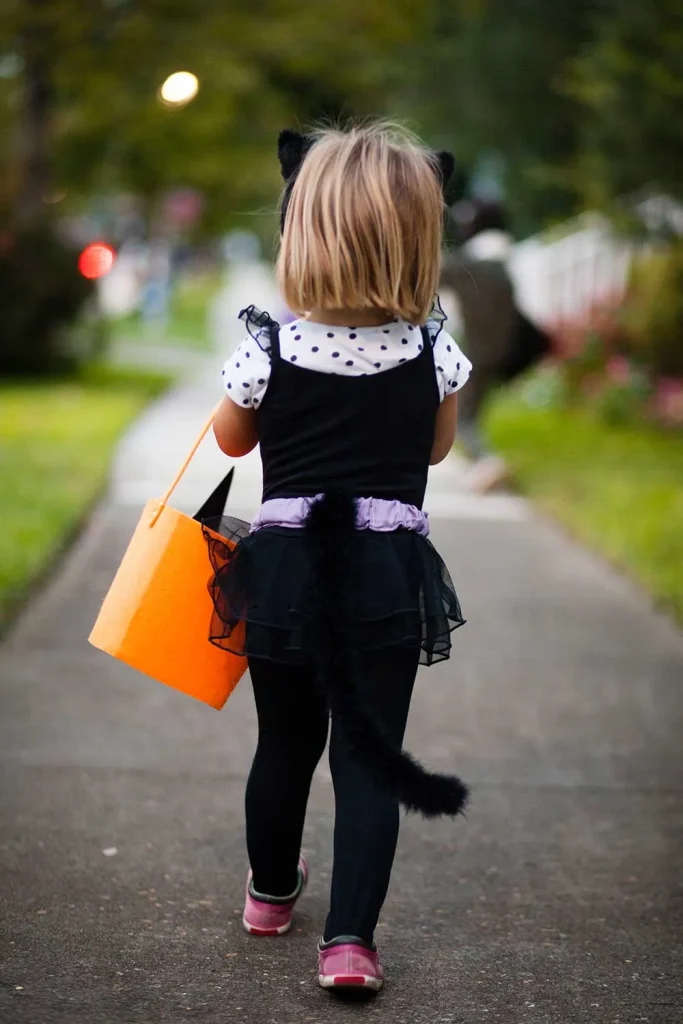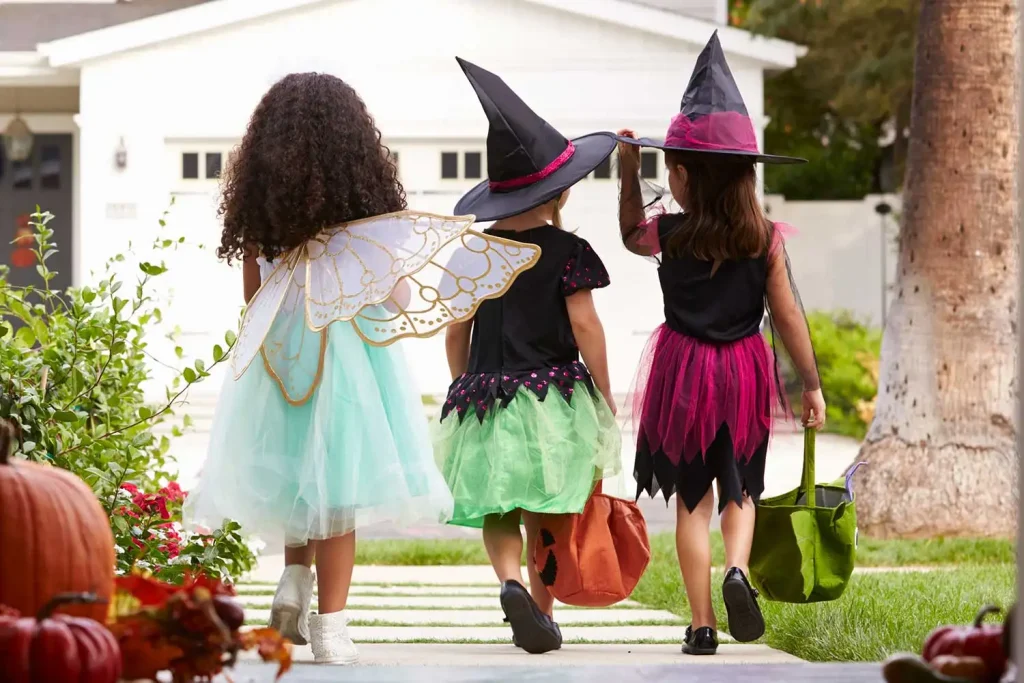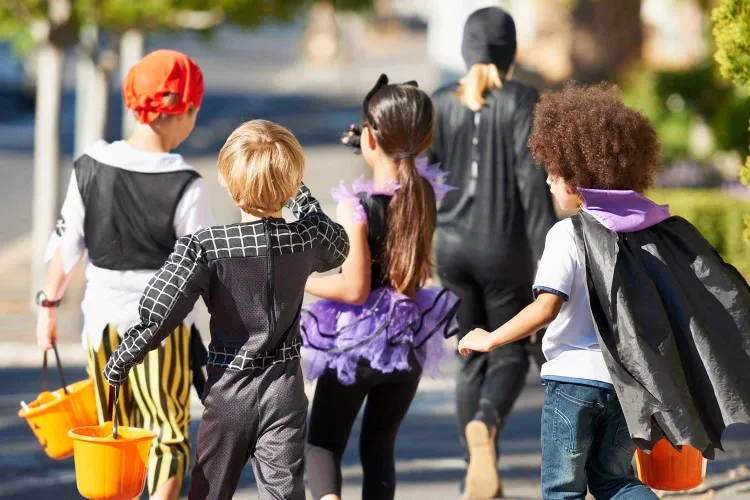A Woman Living in an Upscale Neighborhood ‘Ruined’ Halloween for Thousands After Shutting Down a Beloved Trick-or-Treat Tradition — But Her Side of the Story Changes Everything
Halloween in America has long been a night of shared joy — a mix of nostalgia, costumes, laughter, and candy that brings neighborhoods to life under the glow of porch lights and jack-o’-lanterns. But for one homeowner in an affluent neighborhood, what began as a wholesome community celebration spiraled into chaos. And when she finally took a stand to protect her home and her safety, the internet labeled her the woman who “ruined Halloween.”

It happened in a picturesque suburban community known for its wide tree-lined streets, sprawling lawns, and big seasonal decorations. Each year, the neighborhood transformed into a Halloween paradise. Residents went all-out — from fog machines and animatronic zombies to custom-built haunted houses that drew crowds from neighboring towns. What began years ago as a small gathering of trick-or-treaters had grown into a full-scale event, one that attracted hundreds, then thousands of children and parents eager to experience the “rich neighborhood” candy extravaganza.
Among the participants was one homeowner who initially loved the tradition. She decorated her yard, handed out candy by the handful, and took joy in seeing the excitement on children’s faces. But over time, the crowds became unmanageable. Cars lined both sides of the street for blocks, traffic clogged the entrances, and unfamiliar faces began showing up by the hundreds. Each year, the event ballooned in size, and what once felt like a celebration of community started feeling like an invasion.
This past Halloween, things reached a breaking point.
According to social media reports and local interviews, the woman — whose name was withheld for privacy — decided not to participate in the tradition this year. She didn’t decorate her home, didn’t turn on her lights, and placed a polite but firm sign at the edge of her property asking visitors to skip her house. “No candy this year. Please respect private property,” it read.

But the decision sparked outrage. As dusk fell and word spread that one of the neighborhood’s most well-known homes wasn’t giving out candy, disappointed trick-or-treaters flooded social media with complaints. Posts on Facebook and local community forums quickly went viral. One parent wrote, “She lives in a neighborhood that benefits from our traffic and attention every year — how selfish can she be?” Another user called her “the Halloween Grinch.” Within hours, the story had taken on a life of its own, with thousands weighing in, most without knowing the full story.
Behind the scenes, however, the reality was far from what online commenters imagined. The woman later explained that her decision wasn’t about being unkind — it was about safety and sanity. She had spent years dealing with the overwhelming crowds that descended upon her street every October 31st. “It stopped being about the neighborhood kids a long time ago,” she explained to a local reporter. “People drive in from different cities. We’ve had groups of teenagers pushing, trampling through flower beds, people parking on our lawns, and even fights breaking out in the street. It’s not a safe environment anymore.”
Neighbors backed up her story. Several residents reported that their neighborhood had effectively turned into a public event, with thousands of visitors each year. Some even rented portable toilets and hired security just to handle the crowds. Streets became impassable, sidewalks overflowed, and families who once enjoyed the fun began dreading the chaos.
One longtime resident described it as “Halloween Disneyland gone wrong.”

Police were eventually called to direct traffic and manage safety concerns, but even with extra patrols, things were often out of control. “When you have 2,000 or 3,000 people walking through a residential neighborhood, it’s impossible to manage,” another resident said. “At some point, it stopped being about community and started being about spectacle.”
The woman’s choice to step back this year was, in her eyes, an act of self-preservation. She told local outlets she had been dealing with property damage and exhaustion from trying to maintain order. Last year, she said, her front yard was trampled by visitors cutting across her grass, and candy costs alone had exceeded $600. She added that one year, her dog was nearly injured after being startled by fireworks set off by teens nearby.
But despite her reasoning, the backlash online was relentless. Some accused her of lacking community spirit, while others suggested she was “too rich to care.” Yet amid the noise, voices of empathy began to emerge. Parents who had lived through similar chaos in other neighborhoods chimed in, saying the woman’s actions were understandable. “People forget that homeowners don’t sign up to host a citywide event,” one commenter wrote. “It’s easy to call her selfish, but until you’ve spent all night cleaning trash off your lawn, you don’t really understand.”
The story soon drew national attention as a case study in how modern traditions can spiral out of control. Halloween has become an increasingly elaborate holiday, with some neighborhoods becoming known destinations for trick-or-treating. Families travel from miles away to visit areas that offer full-size candy bars, themed decorations, or celebrity-style setups. While many residents embrace the attention, others find themselves overwhelmed by the sheer scale — and powerless to stop it once it becomes an expectation.
Sociologists note that this kind of situation reflects a broader tension between nostalgia and modern spectacle. What once was a door-to-door neighborhood ritual has, in some communities, turned into a performance — a social media event complete with drone footage, livestreams, and viral posts. And for homeowners caught in the middle, it can be both emotionally and financially draining.
In the days after Halloween, the woman’s story continued to make headlines. Local reporters interviewed other residents, many of whom agreed that change was overdue. “We love Halloween, but it’s gotten out of hand,” one neighbor said. “People treat our neighborhood like a theme park. We’ve had kids come from an hour away. Nobody wants to ruin the fun, but there has to be a limit.”
Even local police weighed in, acknowledging that the event had grown to an unsustainable level. “We received more calls than we could handle,” an officer said. “Crowd control, parking violations, lost children — it was chaos.”
Eventually, the woman herself released a brief statement online. She thanked those who had supported her and reiterated that her decision wasn’t made lightly. “I’ve always loved seeing kids enjoy Halloween,” she wrote. “But when a tradition stops being safe and respectful, it’s time to rethink how we do it. I didn’t ruin Halloween. I just decided to opt out of something that stopped feeling like Halloween years ago.”
Her post shifted the conversation. Many began to see her story not as one of selfishness, but of boundaries — a reminder that even the most joyful traditions can lose their meaning when they grow too big to handle.
The debate still lingers, though. On social media, some continue to argue that community spirit requires sacrifice, while others say safety and sanity must come first. But what’s undeniable is that the story struck a chord nationwide, highlighting the delicate balance between tradition and personal space, generosity and exhaustion.
For the woman at the center of it all, Halloween has likely changed forever. Whether next year brings another wave of crowds or a quieter evening remains to be seen. But her experience has opened a wider conversation about how we celebrate — and when it’s okay to say enough is enough.
In the end, perhaps what happened in that “rich neighborhood” wasn’t about wealth or entitlement at all. It was about the limits of generosity and the unseen toll of trying to live up to everyone else’s expectations. For one woman, saying no was an act of courage in a world that demands constant participation.
And for the thousands who read her story, it was a reminder that sometimes, even the kindest traditions need a moment to rest.


